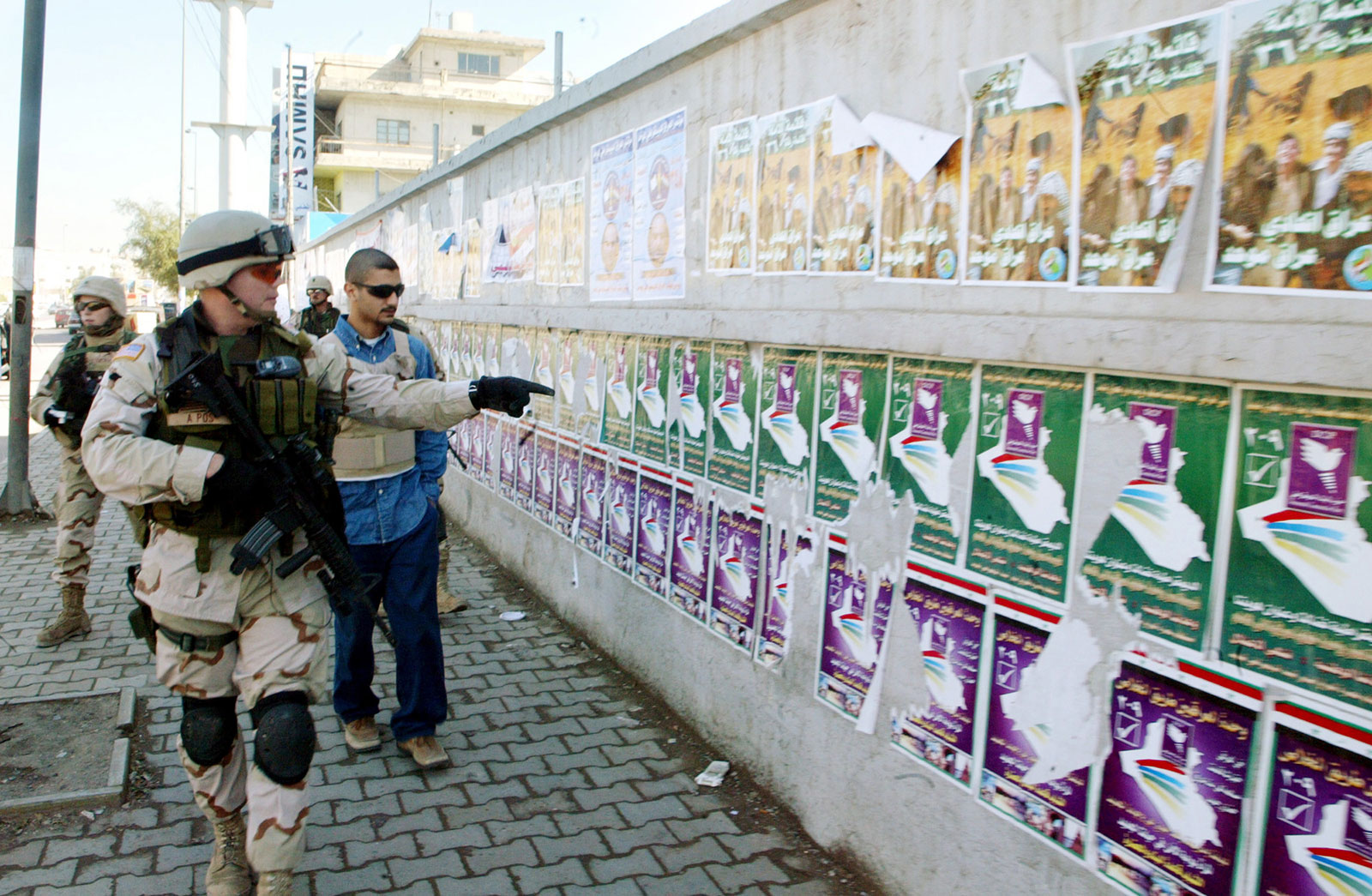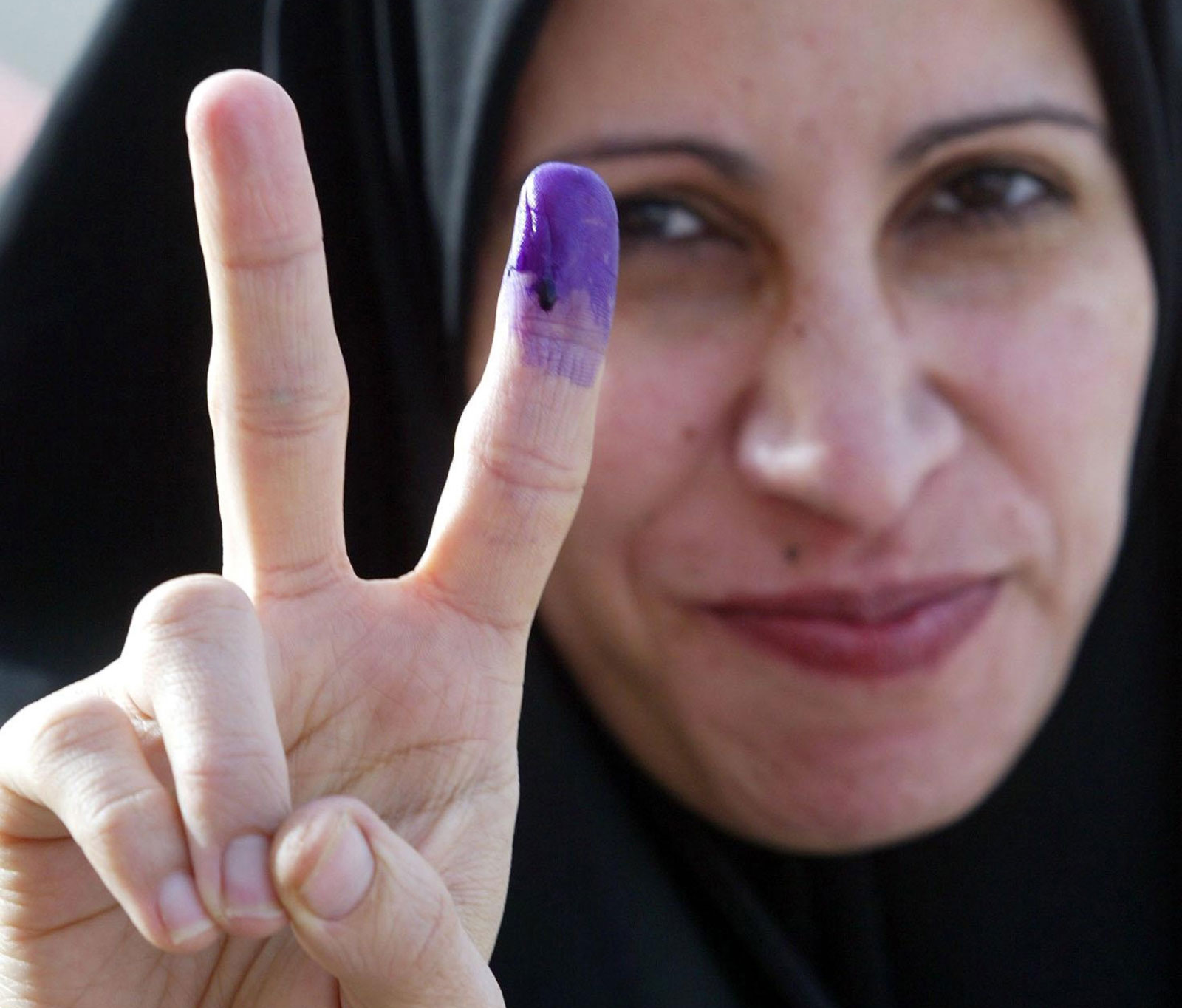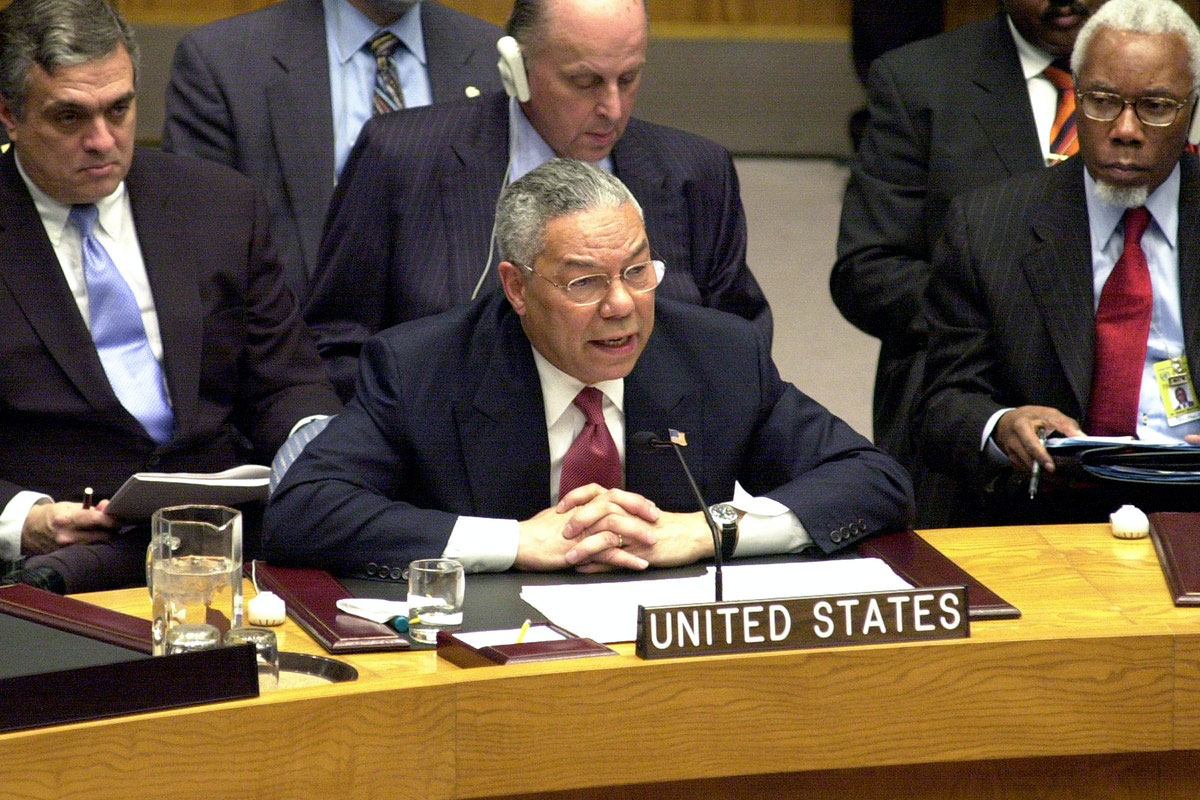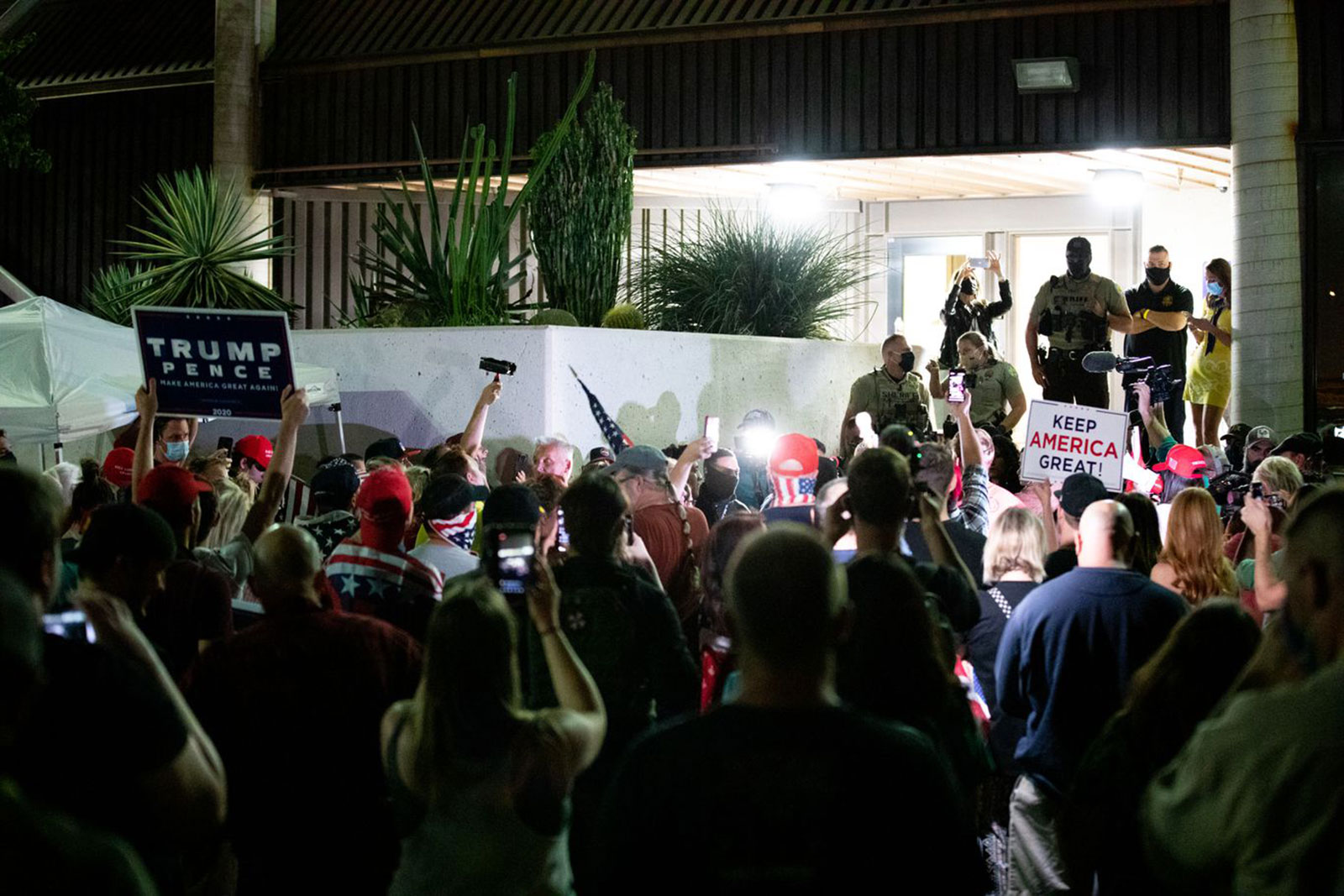Democracy Is a Long Shot
What does a legitimate election look like?
Ryan S. Jeffery

In her 2006 feature film My Country, My Country, Laura Poitras documents the immense amount of work that goes into the appearance of an election’s legitimacy. The election in question was for the Iraqi parliament in 2005, the first since the US occupation in 2003. For the US military planners and UN officials, legitimacy was paramount. And yet, regardless of context, the project of self-rule—or, rather, its appearance—never ceases to face this challenge. “This is what democracy looks like” becomes “This is what legitimacy looks like.”
Poitras locates the drama by embedding her camera in Frederick Wiseman–like fly-on-the-wall fashion in drab fluorescent-lit rooms where US military contractors in Hawaiian shirts and Texan accents deliberate with UN contractors in fleece vests and French accents over how long is too long for “sensitive materials” to sit on a tarmac. Ballots need to get to the warehouses but ballot boxes and lids can sit for hours; “That’s not a showstopper,” as one planner puts it. An election, like any production, requires a careful choreography of arranged images presented out front and the unglamorous work backstage. Poitras underscores this by juxtaposing two types of images: photos of the ink-covered fingers of Iraqis who had certified their ballots, which were widely circulated throughout the international media as symbols of a supposed new era of Iraqi sovereignty, and behind-the-scenes shots of warehouses, tedious meetings, and cargo planes. “This is what legitimacy looks like” becomes “This is what logistics looks like.”

In the end, according to official accounts over one hundred polling sites were attacked, nine on election day. Forty-four people were killed, and the Sunni Party boycotted the election, with only 2 percent voter participation in the Anbar Province.[1] Despite the controversies, a transitional government was nevertheless formed as enough voters accepted the elections as free and democratic.[2]
In November 2020, Americans and many in the rest of the world were transfixed by images of volunteer election workers monotonously counting ballots for the US presidential election in community centers across states such as Pennsylvania, Georgia, and Arizona. Breaking news split screens juxtaposed the quiet counting and sorting of ballots on the inside with the spectacle of diehard supporters of the incumbent president waving flags and chanting outside voting centers. Is this what illegitimacy looks like?
Much has already been made of how both QAnon and Russiagate fit into the longer histories of societal breakdowns in public trust.[3] Illegitimacy can, of course, come from any direction. Out of the heightened ecosystem of conspiracy, fake news, and disinformation, municipalities across the United States decided to livestream their ballot-counting process for the election using the various surveillance platforms now available, such as Angelcam, Google’s Nest, and, most commonly, YouTube’s livestream feature.[4] An anxious electorate had twenty-four-hour access to the silent video feed of the essential work needed to make an election run, in much the same way as they did to the online feed of the new baby pandas in the San Diego Zoo. How the images we saw from these live video streams were supposed to assure us that there was no fraud was not entirely clear, other than the very fact that county offices had provided the livestream. No matter how wide the lens or how long the uninterrupted shot, a certain amount of faith is still required to accept that what we are seeing is evidence of a faithful counting of ballots, that these are even real ballots, or that the event is in fact taking place where it’s claimed. How deep does the uncertainty run?[5] Tossing out ballots or even staging a fake ballot-counting scene must be a lot easier than faking a moon landing. For some ardent skeptics, the camera cases of the news media—those tasked to document and faithfully report, or politically obfuscate, depending on your ideological view—appeared as the perfect vessels for smuggling out undesired ballots. The unreliability of the camera as a record of truth shifts from metaphorical black box to a literal one.
Filmmakers and image theorists like Jean-Luc Godard, Georges Didi-Huberman, and Hito Steyerl remind us of the ambivalent relationship between documentary and truth. It’s a balancing act of “too much and too little … at the same time,” in Steyerl’s description. “If one demands too much of [pictures]—the ‘whole truth’—then disappointment results; suddenly the pictures are just torn shreds, pieces of film, thus inadequate. If one demands too little of them and relegates them to the realm of the simulacrum, they are thus excluded from the historical field.”[6] Steyerl cautions us against an all or nothing understanding of images. The double bind of the photograph’s testimonial power can be instructive in how to understand the instrumentalization of the livestreamed ballot counting in, say, Arizona’s Maricopa County. County election officials there were likely not considering the nuances of image politics in their attempt to assuage a skeptical electorate. Is livestreaming ballot counting as proof of the election process’s integrity a case of asking too much? A desperate attempt to avoid an impending legitimacy crisis by demanding that these images deliver the “whole truth”? Conversely, are the “Stop the Steal” protestors guilty of asking too little or nothing at all? Blinded by confirmation bias and predisposed to see everything as simulacrum?

According to Didi-Huberman, the fulcrum between the picture’s two poles of too much and too little is the word, or language more broadly. “Language and image are absolutely bound to one another, never ceasing to exchange their reciprocal lacunae. An image often appears where a word seems to fail; a word often appears where the imagination seems to fail.”[7] The truth of an image is not just incomplete or partial, but can only be understood out of a constructed meaning through social and political discourse. Here, both Didi-Huberman and Steyerl reach for what Michel Foucault called the “politics of truth,” something distinct from the so-called post-truth politics of today. Instead, the politics of truth was what Foucault identified as how mechanisms of power set the rules to circumscribe what can be determined true or false. But Foucault is quick to clarify this should not be equated with the dictate by a sovereign over truth or falseness.[8] Rather, it is how public opinion is formed and modified through a web of institutional and societal relations that allow for certain discourses and foreclose others; in other words, what sets of knowledge are—or are not—allowed on the table for public opinion to form a consensus around. As an example, Steyerl points to the Bush administration’s 2003 testimony to the United Nations over Iraq’s alleged secret arsenal of weapons of mass destruction. They had photos too. US intelligence agencies assembled a trove of written and visual documents to make their case that Iraq was outwitting weapons inspectors, complete with satellite photography that claimed to verify the existence of the weapons sites. Of course, UN inspectors never found any weapons of mass destruction before, or after, the US occupation of Iraq. Two years after the UN weapons inspectors left, Laura Poitras was filming UN election inspectors. Another two years, and presidential candidate Barack Obama was on the campaign trail criticizing the “flawed ideology” behind the US invasion of Iraq, and in 2015, candidate Donald Trump full-throatedly accused the Bush administration of lying. As president in 2018, Trump flatly stated in a live televised rally that “what you’re seeing and reading is not what’s happening”—a rhetorical pincer move that negates the relationship between images and words by negating both altogether.

Again, we return to the livestreamed ballot counting. Where do these images sit between the demands of too much or too little? The forty-fifth president’s motive for his claim aside, what are we in fact seeing and reading? Over the four years since Trump’s election and the Brexit vote, many have pointed out the hubris that characterized the ruling consensus in the two countries and how their brand of the “politics of truth” led to the undermining of their own legitimacy.[9] Or as sociologist Will Davies describes it: how a sense of strategic concealment of the truth on the part of some ruling elites paved the way for an insurgency of fabricated truths by another set of elites.[10] Yet, this same era has also been marked by the US news media’s staunch focus on nearly every governmental procedure, minor appointment, and customary norm, with livestreamed events playing a key role. This is an outcome of both supply and demand. On the supply side, the latest advents in video and networked technologies have eased the way for the proliferation of livestreaming. While on the demand side, a cultural desire for and expectation of perceived authenticity and unmediated access, as well as an uptick in activism and civic engagement, have coalesced around a body politic in a state of constant informational intake. In the center of this top-down, bottom-up dynamic sits the transition of the US corporate news media into conflict-based infotainment running twenty-four hours a day. YouTube’s first two experiments with livestreaming are emblematic of the twin forces of cultural and political power: a U2 concert in 2009, followed by a 2010 question-and-answer session with President Barack Obama.[11] Of course, C-Span first started broadcasting the US government’s legislative proceedings live on cable television in 1979, during a bygone era when broadcast stations concluded the night’s programming with the “Star-Spangled Banner” over the image of the US flag followed by static. Back then, who wanted to watch democracy? By 1997, however, C-Span had expanded its intrepid mission of sousveillance to the information superhighway with C-Span.org. A Twitter account followed in 2009 and the company began livestreaming on its Facebook page in 2011.[12] In December 2016, it went so far as to set up in the lobby of Trump Tower to livestream the parade of potential advisors and cabinet officials meeting with president-elect Trump.[13] The stage for NBC’s Apprentice had become the stage for US political theater. Since then, livestreaming government proceedings has only proliferated further across platforms like YouTube and to nearly every major news outlet’s website.

In 1989, during the Romanian Revolution, demonstrators occupied a state TV station in Bucharest and broadcast footage of the uprising for 120 hours straight. Three years later, filmmakers Harun Farocki and Andrei Ujica used this footage, along with amateur footage of the protests from the streets and rooftops, to construct their film Videograms of a Revolution. For Ujica and Farocki, the writing of history is in no small part an outcome of media’s relation to narrative: first as literature and theater, then cinema in the twentieth century. By the end of that century, video and televisual representation dominated, prefiguring the role of the smartphone camera and the digital networked technologies of today. Though it may seem a far cry from Romania during the fall of the Soviet Union, returning to the protest of Maricopa County’s ballot tabulation allows us to juxtapose two discrete moments of democratic demand and challenge to legitimacy: the occupation of Romanian state TV to call for expanded democratization, and the occupation of an Arizona voting center parking lot to protest an alleged threat to democracy. The latter would later prove itself a precursor to the incoherent, if not inchoate, insurrection attempt against the formal submission of the presidential election results in the US Capitol.
What, if anything, can the antagonism between the image of election work and the image of election protest tell us about the use and abuse of images in politics in the era of digital information sharing and networked power? Let’s take the split screen offered by local and national news outlets that ran live footage of dutiful election workers inside and defiant election protesters outside, and instead juxtapose the state’s own live feed of ballot counting with a live feed from a protestor’s smartphone. With the news networks’ intermediate role out of the picture, this new split screen distills a fundamental conflict between two sets of authority—between constitutional order and the individual’s demand on it, and their willingness, or unwillingness, to consent to it. This juxtaposition complicates not just media authority and political authority but also suggests what philosopher Étienne Balibar claims to be the instability that the insurrectionary demand produces within the tradition of the rights of citizenship. Writing on Videograms, media scholar Benjamin Young draws on Balibar’s framework to tease out what he sees as a tangled relation between revolutionary demand, visual representation, and political legitimacy. As Young describes it, the emphasis on seizing images reveals “the oscillation between what [Balibar] calls insurrectionary and constitutional politics, between permanent, uninterrupted revolution and the state as institutional order.”[14] Democracy, in this view, is only legitimate insofar as it cannot be predicted. That is the tension: between the collapse of consent and the threat of insurrection, on the one hand, and the need for institutional order and constraint, on the other. The fact that we do not know what’s going to happen next is precisely the point. If the stakes seem heightened and the struggle endless, it’s because they are.


The question remains for whose benefit the ballot-counting feed was intended. Were these images of the normally behind-the-scenes election work provided in the sincere belief that they might actually circumvent a coming conflict, or were they always understood as the necessary first shots in just another inevitable battle over the terrain of images? What role, if any, can the image play in fostering a productive political contestation? It appears that no amount of high-resolution detail (or, as Mitt Romney put it on the Senate floor hours after the US Capitol riot, no extent of audits) will convince some voters of the election results. Some have committed to remaining unconvinced. Some will always look in bad faith. Perhaps not everything can always be negotiated. At some point, the camera lens can’t go wide enough. At some point, the data storage runs out. As the narrator in Videograms of Revolution flatly states at the film’s opening, “The camera gets as close to the events as the lens allows.” Every image is a limitation. Whatever democracy may “look like,” its image is not the binary choice of the voting booth or the barricades. Autonomist and anarchistic traditions have long pointed out how each of these shallow images circumscribe and reduce democratic practice into either the obligatory consent of filling out a ballot or the defiantly raised fist. Neither is what democracy looks like. But it’s safe to say that it’s what elections will continue to look like. No doubt, the cameras and data centers will be ready to capture and stream the next one.
- See “Q&A: Iraqi Election,” BBC, 13 February 2005. Available at news.bbc.co.uk/2/hi/middle_east/3971635.stm.
- See “Timeline: Iraqi Elections,” Al Jazeera (3 March 2010). Available at aljazeera.com/news/2010/3/3/timeline-iraqi-elections.
- Branko Marcetic, “Stories for the End of the World,” Jacobin (online), 27 November 2020. Available at jacobinmag.com/2020/11/stories-for-the-end-of-the-world.
- Tanya Basu, “Vote Count Livestreams Are Here to Stay,” MIT Technology Review (online), 4 November 2020. Available at www.technologyreview.com/2020/11/04/1011648/livestream-vote-counts-are-here-to-stay.
- See, for example, “Not Real News: A Look at What Didn’t Happen This Week,” AP News, 6 November 2020. Available at apnews.com/article/election-2020-ap-fact-check-pennsylvania-media-social-media-cffc1bf12660177b0c651f98054a3a76.
- Hito Steyerl, “Documentarism as Politics of Truth,” trans. Aileen Derieg, Transversal 10/03 (October 2003). Available at transversal.at/transversal/1003/steyerl/en.
- Georges Didi-Huberman, Images in Spite of All: Four Photographs from Auschwitz, trans. Shane B. Lillis (Chicago: University of Chicago Press, 2008), p. 26.
- Michel Foucault, Security, Territory, Population: Lectures at the Collège de France, 1977–78, ed. Michel Senellart, trans. Graham Burchell (New York: Picador, 2009), p. 275.
- On the hubris of American and British politicians, see Pankaj Mishra, “A Generation of Failed Politicians Has Trapped the West in a Tawdry Nightmare,” The Guardian (online), 1 January 2016. Available at theguardian.com/commentisfree/2016/jan/01/generation-failed-politicians-elite-liberal-values. On the “politics of truth,” see Ben Davis, “Beyond the Imaginary Politics of Objective Facts,” Walker Reader (21 June 2017). Available at walkerart.org/magazine/ben-davis-truth-fact-politics.
- William Davies, “Why We Stopped Trusting Elites,” The Guardian (online), 29 November 2018. Available at theguardian.com/news/2018/nov/29/why-we-stopped-trusting-elites-the-new-populism.
- Doug Gross, “YouTube Testing Live Streaming,” CNN, 13 September 2010. Available at edition.cnn.com/2010/TECH/web/09/13/youtube.livestreaming/index.html.
- Radhika Marya, “C-SPAN Expands Social Media Outreach in Time for 112th Congress,” Mashable, 5 January 2011. Available at mashable.com/2011/01/05/c-span-expands-social-media-outreach-in-time-for-112th-congress.
- Together with Travis Diehl, I made a film, The Triumphs & the Frauds, that consists only of footage from the C-SPAN stakeout in the Trump Tower lobby on 14 December 2016. The film depicts the inner monologue of a camera operator frustrated by the search for a subject in the 45th American president’s disorienting transition to power. The title derives from a passage in Orson Welles’s last feature, F for Fake—quoted at the end of our film—where Welles muses on authorship, ego, and the fleeting fate of the individual name. The Triumphs & the Frauds enters the drudgery that makes possible the twenty-four-hour political spectacle: the labor of infotainment, where boredom deepens into delirium.
- Benjamin Young, “On Media and Democratic Politics: Videograms of a Revolution,” in Harun Farocki: Working on the Sight-Lines, ed. Thomas Elsaesser (Amsterdam: Amsterdam University Press, 2004), p. 254.
Ryan S. Jeffery is a filmmaker who lives in Los Angeles. His most recent film, An Unsatisfying Metaphor, tells the story of modern globalization through the lens of the World Trade Organization’s private art collection located in Geneva, Switzerland.
If you’ve enjoyed the free articles that we offer on our site, please consider subscribing to our nonprofit magazine. You get twelve online issues and unlimited access to all our archives.